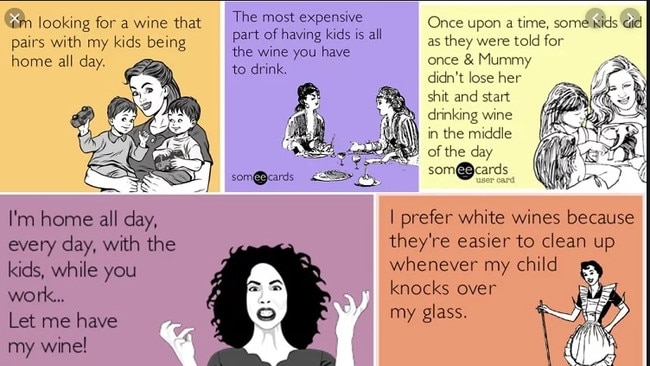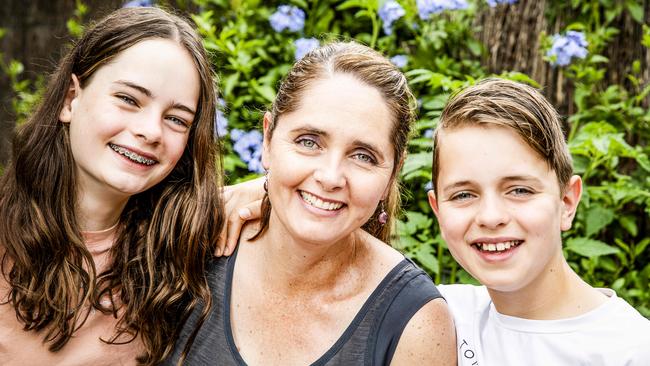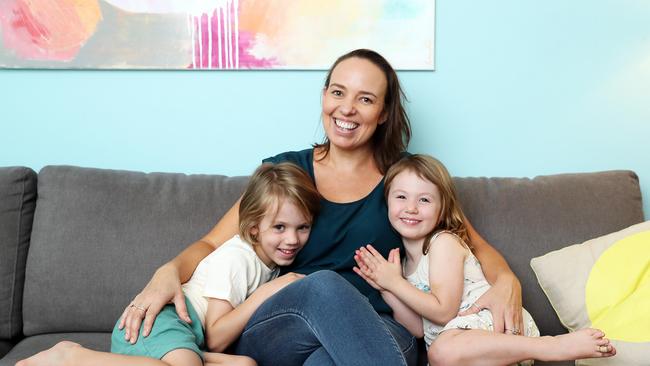‘Wine o’clock’ for stressed mums linked to breast cancer
An increasingly popular daily habit among Aussie mums risks sparking a national health crisis, with parents who drink as an act of self-care warned that just a few glasses each day could put them at risk of breast cancer.
Health
Don't miss out on the headlines from Health. Followed categories will be added to My News.
Exclusive : The rise of the daily ‘wine o’clock’ habit for Australian mums is poised to have significant health implications, with research showing for women, drinking half a bottle of wine a day increases the risk of breast cancer and is equal to smoking five cigarettes.
Experts are warning the meme-driven culture of mums indulging in self-care by drinking could become a health crisis for governments, with new data from the federally funded Daybreak digital service, that helps people reset their drinking habits, revealing three-quarters of members are women, a third are aged in their 40s, most drink alcohol four or more days a week and on a typical drinking day, nearly half would consume five or more drinks in a session.

An Australian not-for-profit that is disrupting the traditional AA model, Daybreak is an app with nearly 70,000 people registered worldwide and 45,000 Australians.
It comes as the federal government is working towards the formal release of its new alcohol consumption guidelines, which reduces the amount of alcohol consumed down to 10 weekly drinks.
But Trish Hepworth, from Foundation for Alcohol Research and Education (FARE), warns 84 per cent of people aren’t aware of the cancer link with alcohol. New data, especially collated for News Corp Australia by FARE, shows drinking a few glasses of wine a day increases the risk of breast cancer by six per cent with ‘five cigarettes’ in each half bottle of wine.
“Given the strong causal relationship between alcohol and breast cancer, for a woman, drinking half a bottle of wine is equivalent to smoking five cigarettes,” said Ms Hepworth, noting the risk is not the same for men.
“So if a husband and wife both share a bottle of wine – the level of risk is markedly different,” she said, adding that data from the Australian Institute of Health and Welfare showed a rise in risky drinking behaviour in women in their 40s, 50s and 60s between 2001- 2016, in comparison to younger age groups who have dropped in the same time period.
Ms Hepworth said an increased risk of 6 per cent should be taken seriously.
“It is a risk level that we wouldn’t accept in most other things, for example your water supply or risk of dying in a car or aeroplane crash,” she said, adding she would like to see health warnings on bottles similar to cigarette packets.
“Basically if women cut down their drinking we would cut down the rates of breast cancer.”

‘IT MAKES YOU FEEL LIKE YOU’RE NOT A FAILURE’
Victorian mother of two Kate Riordan, 45, joined Daybreak after realising that AA wasn’t for her.
“For me drinking was boredom and also reward. And when you are drinking it is something you can do easily while you are cooking the dinner or folding the washing,” she said.
“I was drinking nearly every night, half a bottle roughly. I’d wake up at three and couldn’t get back to sleep and felt sick all day.”
“In the beginning I would go to the app seven times a day. Every time I was craving or really struggling. It makes you feel like you are not a failure.
“People on there would say ‘my kids are driving me insane’ or ‘when I put the kids to bed I am really missing my reward’ so you don’t feel alone.”

Professor Kate Conigrave, Chair of the NHMRC Alcohol Working Committee and mother of five, said the modern world is catching up with working mums who are treating themselves to a few glasses of wine in the small window in between putting the children to bed after getting home from work and going to bed themselves.
“You model what a mother should be based on what your mother did but you are trying to do it on top of work and women put a lot of pressure on themselves. They care deeply about their children and they are also trying to do a good job – and these days people are surviving mortgages, they often have no choice but to work and are trying to be all things to all people; mother, wife, partner and professional – it all adds pressure.”
Professor Conigrave said there are low levels of awareness of the alcohol recommendations and what a standard drink looks like.
“It is actually only 100 mls and most people are typically pouring about 180 mls.”
She warned people who drink several drinks per day can have an increase in anxiety in between drinks: due to some low grade withdrawal symptoms.
“So they can get locked into a cycle. The alcohol is giving short term relief to anxiety, but all the while it is increasing the level of anxiety.”
‘I WASN’T AN ALCOHOLIC, BUT DAYBREAK STILL HELPED’
Mum of two Jada Bennett-Cross said the stress of her events job, coupled with parenting, lead her to drinking unhealthy amounts of alcohol.
“I’d drink a bottle of wine like a bottle of water. It would hit five o’clock, the kids were being difficult and I’d had a hard day. Especially when I went back to work and was juggling it all – it became my fall back and my stress relief,” she said.
Ms Bennett-Cross said her drinking got worse when she started juggling work with motherhood.
“I had always known I didn’t have a healthy relationship with alcohol but didn’t characterise myself as an alcoholic and I still don’t. The best thing about Daybreak for me was it was 24/7 and in my pocket.
“I could talk to women in a similar age bracket and most of them have kids too.”

Daybreak’s psychologist Briony Leo said that the majority of the women seeking help are high-functioning working mums.
“They over achieve at work, as parents, as daughters and sisters and partners – but at the end of the day are often left feeling empty and exhausted.
“Often wine can be a positive thing when used in moderation. The issue is that it can be a bit of a diminishing return.”
Minister for Health Greg Hunt said the new alcohol guidelines will be communicated to the public through a range of channels and said the National Alcohol Strategy targets adults in their 40s, 50s and 60s as one of the population groups that may experience higher levels of harm from alcohol.
The new draft 2019 guideline recommendations are: To reduce the risk of harm from alcohol-related disease or injury for healthy men and women, drink no more than 10 standard drinks per week and no more than four standard drinks on any one day.
